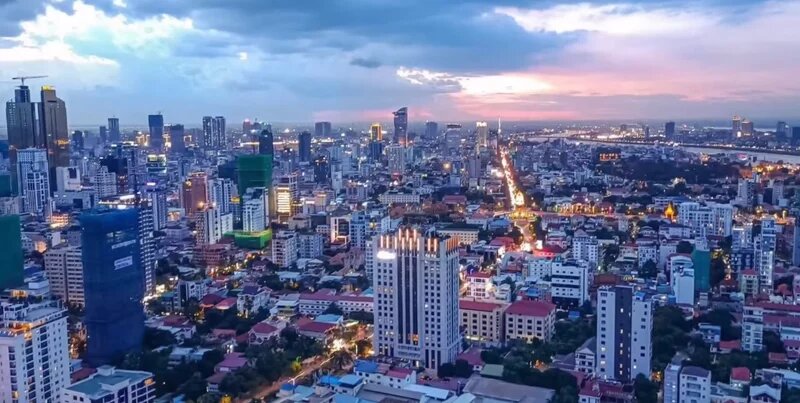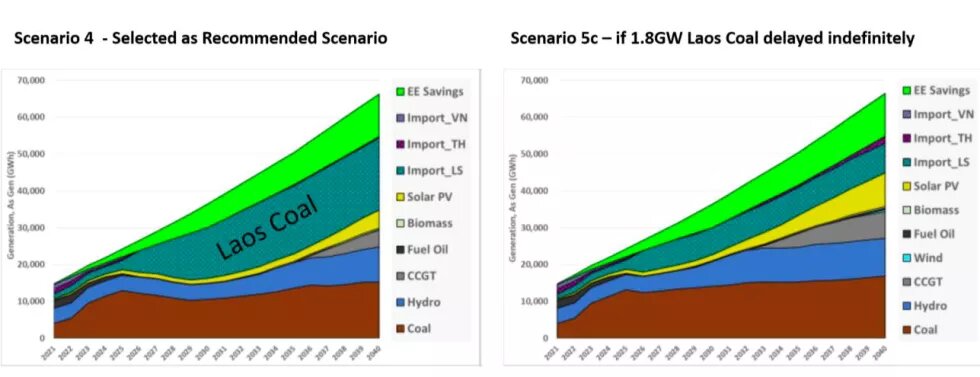
Energy status In a nutshell
In 2004, Cambodia's electricity grid was dominated by fossil fuels -primarily heavy-fuel oil and diesel; by 2013, it was completely transformed with 82% renewable sources: mostly hydropower. This essential progression may indeed reverse: Cambodia plans to import coal power from Laos to meet its demand in 2030, thereby increasing - to 74% or 3/4s - the electricity in its national grid from non-renewable sources. While Cambodia is moving in this direction, the government has also committed to net-zero by 2050, making this plan difficult to achieve as energy emissions keep increasing.

A closer look at the renewable energy in Cambodia
Cambodia has three main renewable energy types: hydro, solar, and biomass. In 2020, hydro represents almost half of the energy mix (EAC, 2020). Solar accounts for 3%, and about 1% comes from biomass. 2021 followed a similar trajectory with a 3% increase in solar. Under the recently proposed plan from the government, solar energy will make up around 9% by 2040.
What are the opportunity and challenges for energy transition for Cambodia?
Opportunity
"The government … strongly promotes clean energy to benefit the country’s green economic development," said Minister of Environment Say Samal during his meeting with the Minister of State for Asia, Amanda Milling, in Glasgow city, United Kingdom.
An analysis of Cambodia’s renewable energy working group shows that Cambodia has excellent solar and wind potentials, bringing green investments and jobs, energy security, energy independence as we rely less on imported coals, and lower electricity prices. Cambodia, so far, has made good progress on solar energy. Renewable energy such as solar and wind make electricity prices economically viable and sustainable for the environment. The prices of these technologies have dropped drastically in the last ten years (IRENA, 2020). In 2017, Cambodia welcomed its first 10 MW solar farm in Bavet province at the cost of 9.1 c/kWh, cheaper than the average cost of the electricity supply, which was 9.5 c/kWh (ADBCIF, 2020). Through public-private partnerships arranged by Asian Development Bank (ADB) with Electricity du Cambodge (EDC) in 2019, Cambodia has achieved a 60 MW tendered at the price of 3.877 c/kWh, making this the lowest electricity for a solar project in Southeast Asia (ADB, 2019). This was followed by another ADB-supported tender for a 40MW solar farm. The price was announced in April 2022 as 2.6c/kWh (EDC, 2022).
Wind projects are yet to be introduced in Cambodia. The Blue Circle, a Singaporean wind company, has offered 6.85 c/kWh to EDC. However, the project hasn’t closed the deal yet. By unlocking these projects, Cambodia can gain cheaper electricity for its consumers and create job opportunities for the country.
Challenges
In the recent announcement on the proposed power development plan in 2040, the government has chosen scenario 4, shown in Figure 1; Scenario 5c will be adopted as a contingency plan. There will be some challenges with this plan. During the annual UN summit in 2021, President Xi Ji Ping said, "China will step up support for other developing countries in developing green and low-carbon energy, and will not build new coal-fired power projects abroad." This will affect coal projects abroad and in the countries. Another challenge is the increasing price of coals. The average coal power price is already double compared to renewable energy. With the increase in global coal fuel prices, the government will be facing a high chance of paying even more for these future projects.
Figure.1
On the other hand, the general public's understanding of technology such as solar and wind is still limited. The inclinations include the belief that these technologies are costly and still new to them. Therefore, it’s positive to say there is room to fill those knowledge gaps. At the university level, for example, there could introduce a renewable energy curriculum for people to see and experience early to spark some interest in these fields.
Renewable energy is here. And it’s cheap and would bring in more investment, jobs, and better energy security in Cambodia, relying less on imports. To realize and act now is significant for Cambodia toward a more sustainable and green future.
References:
ADB-supported solar project in Cambodia achieves the lowest-ever tariff in ASEAN. (2019, November
25). Asian Development Bank. https://www.adb.org/news/adb-supported-solar-project-cambodia-achieves-lowest-ever-tariff-asean
(n.d.). Asian Development Bank.
https://www.adb.org/sites/default/files/publication/167401/adb-cif-country-fact-sheets-2nd-e pdf
(n.d.). EAC. https://eac.gov.kh/uploads/salient_feature/english/salient_feature_2020_en.pdf
Renewables increasingly beat even cheapest coal competitors on cost. (n.d.). IRENA – International
Renewable Energy Agency. https://www.irena.org/newsroom/pressreleases/2020/Jun/Renewables-Increasingly-Beat-Even-Cheapest-Coal-Competitors-on-Cost
